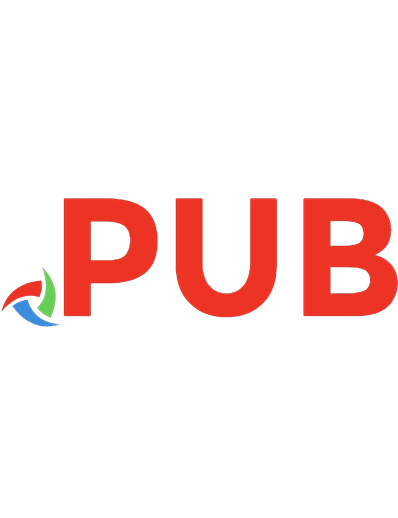An Introduction to Project Modeling and Planning [1st ed. 2021] 9783030614225, 9783030614232
This textbook teaches the basic concepts and methods of project management, but also explains how to convert it to usefu
591 117 19MB
English Year 2021
Table of contents :
Preface
Acknowledgement
Contents
1: Introduction to Project Modeling and Planning
1.1 What Is a Project?
1.2 Project Management in Today´s World
1.3 Challenges in Keeping to Scope, Cost, and Schedule Targets
1.4 A Life Cycle Concept for Projects
1.4.1 Conceptual Design and Project Definition
1.4.2 Planning
1.4.3 Implementation, Monitoring, and Control
1.4.4 Evaluation and Termination
1.5 Post-Project Analysis
1.6 Uncertainty and Risks in Projects
1.7 Project Modeling and Planning Tools
1.8 Resource Constrained Modeling
1.9 Agile Project Management
Exercises
References
2: Organizing and Managing Projects
2.1 Projects and Organizational Structure
2.1.1 Functional Organizations
2.1.2 Project Organizations
2.1.3 Matrix Organizations
2.2 How to Choose the Project Management Structure?
2.3 Stakeholder Management
2.4 Project Management Culture
2.5 Organizing Projects
2.5.1 Steering Committee
2.5.2 Project Sponsor
2.5.3 Project Manager
2.5.4 Project Team and Team Members
2.5.4.1 Desirable Skills and Characteristics of Team Members
2.5.4.2 Geographically Distributed Project Teams
2.5.5 Project Meetings
2.6 Project Management Office
2.7 Program Management
2.8 Project Portfolio Management
2.9 Agile Project Management
2.10 Conclusions, Recent Developments, and Some Future Research Directions
Exercises
References
3: Planning and Network Modeling of Projects
3.1 Project Scope
3.1.1 Project Charter
3.2 Work Breakdown Structure
3.2.1 Decomposition of WBS into Work Packages
3.2.2 Types of WBS Representation
3.2.3 Gantt Chart Representation of Work Packages
3.2.4 Organizational Breakdown Structure
3.2.5 Cost Breakdown Structure
3.2.5.1 Bottom-Up Costing - Cost Aggregation
3.2.5.2 Cost Accounts
3.3 Network Modeling of Projects
3.3.1 Types of Models
3.3.2 Network Modeling of Projects
3.3.2.1 Hammock Activities
3.3.3 Activity on Arc Type Representation
3.3.3.1 Network Construction Rules
3.3.3.2 Checking for Cyclic Project Networks
3.3.4 Activity on Node Type Representation
3.3.5 Generalized Precedence Relationships
3.3.6 Level of Aggregation in Project Networks
3.3.6.1 Milestones
3.3.6.2 Summary Activities
3.3.7 Network Modeling of Multiple Projects
3.4 Estimating Activity Durations
3.4.1 Tools for Estimating Activity Durations
3.5 Cost Management
3.5.1 Tools for Estimating Activity Cost
3.5.2 Types of Project Costs
3.5.3 Activity-Based Costing
3.6 Data, Information, and Knowledge Management
3.6.1 Which Data to Collect?
3.6.2 With Which Frequency to Collect Data?
3.6.3 With Which Tools to Collect and Integrate Data?
3.6.4 With Which Tools and How to Analyze Data?
3.7 Conclusions, Recent Developments, and Some Future Research Directions
Exercises
References
4: Deterministic Project Scheduling with No Resource Constraints
4.1 Introduction
4.2 Critical Path and Its Determination
4.2.1 Critical Path Method
4.2.1.1 Critical Path Method on Activity-on-Arc Type Project Networks
4.2.1.2 Critical Path Method on Activity-on-Node Type Project Networks
4.2.1.3 Criticality and Slacks for the Case of Generalized Precedence Relationships
4.2.1.4 Sensitivity Analysis
4.3 Linear Programming Formulation
4.4 Maximizing the Net Present Value of a Project Under No Resource Constraints
4.4.1 A Zero-One Mathematical Programming Formulation
4.4.2 Time Dependent Cash Flows
4.5 Keeping the Project Plan Current
4.6 Conclusions, Recent Developments, and Some Future Research Directions
4.7 Case Study: Installation of a Plant Biotechnology Lab
Exercises
References
5: The Time/Cost Trade-off Problems
5.1 Problem Definition
5.2 Time/Cost Trade-Off in Projects
5.2.1 Project Crashing
5.2.2 An Algorithm for Project Crashing
5.2.2.1 Determining the Minimum Total Project Cost
5.2.2.2 Generalized Precedence Relationships
5.3 Continuous Time/Cost Trade-off Problems
5.3.1 Activity-on-Arc Representation
5.3.2 Activity-on-Node Representation
5.3.2.1 Model Solution
5.4 Discrete Time-Cost Trade-off Problems
5.4.1 The Deadline Problem
5.4.2 The Budget Problem
5.5 Conclusions, Recent Developments, and Some Future Research Directions
Exercises
References
6: Stochastic Project Scheduling with No Resource Constraints
6.1 Introduction
6.2 Representation of the Randomness of Activity Durations
6.3 Determining the Critical Path
6.4 Shortcomings of the PERT Method
6.5 A Model for Managing Uncertainty in Activity Costs
6.6 Monte Carlo Simulation Approach to Handle Uncertainty
6.7 Conclusions, Recent Developments, and Some Future Research Directions
6.8 Case Study: Constructing an Earthquake Resistant Residential House
Exercises
Appendix 6A: Area Under the Normal Curve
References
7: Resource Constrained Project Scheduling
7.1 Introduction
7.1.1 Categories of Resources
7.1.2 Resource Parameters
7.2 Objective Functions
7.2.1 Regular and Non-regular Objective Functions
7.2.2 Time-Based Objectives
7.2.2.1 The Case of Multiple Projects
7.2.3 Financial Objectives
7.2.4 Quality Based Objectives
7.2.5 Resource Based Objectives
7.3 A Mathematical Programming Formulation of the Resource Constrained Project Scheduling Problem
7.4 Exact Solution Procedures Using Branch and Bound
7.5 Heuristic Solution Procedures
7.5.1 Types of Schedules
7.5.2 Priority Rules
7.5.2.1 A Representative List of Priority Rules
7.5.3 Serial Schedule Generation
7.5.4 Parallel Schedule Generation Scheme
7.5.5 A Brief Assessment of Serial and Parallel Schedule Generation Schemes
7.6 A Mathematical Programming Formulation with Multiple Modes
7.7 A Mathematical Programming Formulation for Maximizing the Net Present Value of a Project Under No Budgetary Constraint
7.8 Conclusions, Recent Developments, and Some Future Research Directions
Exercises
Appendixes
Appendix 7A: Computational Complexity
Appendix 7B: Branch and Bound
References
8: Resource Leveling and Other Resource Management Problems
8.1 Introduction
8.2 Resource Leveling
8.2.1 The Burgess and Killebrew Algorithm
8.2.2 Other Solution Approaches
8.2.3 The Total Adjustment Cost Problem
8.3 Resource Availability Cost Problem
8.4 Resource Management Policies
8.5 The Resource Portfolio Management Problem
8.6 Conclusions, Recent Developments, and Some Future Research Directions
8.7 Case Study: Conducting Annual Audit for Celik Company
Exercises
References
9: Project Contract Types and Payment Schedules
9.1 Introduction
9.2 Contract Types
9.2.1 Fixed Price Contracts
9.2.2 Variable Price Contracts
9.2.3 Cost of Managing Contracts
9.3 Payment Scheduling Models
9.4 Change and Control Issues in Contracts
9.4.1 Managing Change Issues in Contracts
9.4.2 Control Issues in Contracts
9.5 Identification and Allocation of Risk in Contracts
9.6 Bidding
9.6.1 Estimating the Total Cost of the Project
9.6.2 Front-loaded Bidding Strategy
9.6.3 A Bidding Model for Determining the Bidding Price
9.7 Mathematical Models for Negotiation in Project Management
9.7.1 Preparation for a Bid
9.7.2 Client-Contractor Bargaining Problem
9.7.3 Equitable Payment Schedule Problem
9.8 Conclusions, Recent Developments, and Some Future Research Directions
Exercises
References
10: Progress and Cost Control
10.1 Introduction
10.2 Cost/Schedule Control System Measures
10.3 Estimating the Percent Complete
10.4 Cost/Schedule Control Performance Indicators
10.4.1 The Impact of Inflation
10.5 Time and Cost Predictions Using EVM
10.6 Limitations of Earned Value Management
10.7 Conclusions, Recent Developments, and Some Future Research Directions
Exercises
References
11: Project Risk Management
11.1 Introduction
11.2 Processes in Project Risk Management
11.2.1 Risk Identification
11.2.2 Risk Analysis
11.2.2.1 Qualitative Methods
11.2.2.2 Quantitative Methods
11.2.3 Risk Response Planning
11.2.4 Risk Monitoring and Control
11.3 Project Risk Analysis: A Team Discussion Case
11.4 Conclusions, Recent Developments, and Some Future Research Directions
Exercises
References
12: Project Scheduling Under Uncertainty
12.1 Introduction
12.2 Robust Scheduling
12.2.1 Critical Chain Project Management
12.2.2 A Robust Optimization Model for Project Scheduling
12.2.3 Robustness Measures and Project Scheduling
12.3 Stochastic Scheduling
12.4 Sensitivity, Scenario, and Simulation Analysis
12.4.1 Sensitivity Analysis
12.4.2 Scenario Analysis
12.4.3 Monte Carlo Simulation
12.5 Conclusions, Recent Developments, and Some Future Research Directions
Exercises
References
13: Planning and Scheduling of Repetitive Projects
13.1 Introduction
13.1.1 An Analogy to Serial Production Lines
13.1.2 Duration - Resource Relation for WPs
13.2 A Mathematical Programming Model for the Repetitive Projects
13.2.1 The Objective Function
13.2.2 The Constraints
13.2.3 The Mathematical Programming Model
13.3 A Model with an Alternative Total Cost Function
13.4 Conclusions, Recent Developments, and Some Future Research Directions
13.5 Case Study: 50 Km Gebze-Orhangazi Section of Gebze-Izmir Motorway Project
Exercises
References
14: Project and Portfolio Selection
14.1 Introduction
14.2 A Multi-criteria Scoring Model
14.3 The Analytic Hierarchy Process
14.3.1 Sensitivity Analysis
14.4 Mathematical Programming Models
14.4.1 A Single Objective Mathematical Programming Model
14.4.2 Multi-objective Mathematical Programming Models
14.4.3 Multi-objective Linear Programming Approach
14.4.4 Goal Programming Model
14.4.5 Multi-objective, Multi-period Project Portfolio Selection and Scheduling Model
14.5 Conclusions, Recent Developments, and Some Future Research Directions
14.6 Case Study: Project Portfolio Selection for the Construction of a Series of Dams
Exercises
References
15: Recent Developments and Some Promising Research Areas
15.1 Sustainability and Project Management
15.2 Project Management in the Era of Big Data
15.2.1 Meaning and Techniques of Big Data Analytics
15.2.2 Application Areas and Opportunities in Project Management
15.3 Fourth Industrial Revolution and the New Age Project Management
15.3.1 Evolution of the Project Environments
15.3.2 Transformation of the Project Management Practices
References
References for Section Sustainability and Project Management
References for Section Project Management in the Era of Big Data
References for Section Fourth Industrial Revolution and the New Age Project Management
Abbreviations
Mathematical Notations
Index
![An Introduction to Project Modeling and Planning [1st ed. 2021]
9783030614225, 9783030614232](https://dokumen.pub/img/200x200/an-introduction-to-project-modeling-and-planning-1st-ed-2021-9783030614225-9783030614232.jpg)
![An Introduction to Project Modeling and Planning [1st ed. 2021]
9783030614225, 9783030614232](https://dokumen.pub/img/200x200/an-introduction-to-project-modeling-and-planning-1st-ed-2021-9783030614225-9783030614232-y-2536537.jpg)
![An Introduction to Nuclear Fission [1st ed. 2021]
3030845915, 9783030845919](https://dokumen.pub/img/200x200/an-introduction-to-nuclear-fission-1st-ed-2021-3030845915-9783030845919.jpg)

![Introduction to Algorithmic Government [1st ed. 2021]
9811602816, 9789811602818](https://dokumen.pub/img/200x200/introduction-to-algorithmic-government-1st-ed-2021-9811602816-9789811602818.jpg)
![Modeling and Simulation An Application-Oriented Introduction [1st ed.]
9783642395239, 9783642395246, 9783662518427, 3662518422](https://dokumen.pub/img/200x200/modeling-and-simulation-an-application-oriented-introduction-1st-ed-9783642395239-9783642395246-9783662518427-3662518422.jpg)
![Modeling and Simulation An Application-Oriented Introduction [1st ed.]
9783662518427, 3662518422](https://dokumen.pub/img/200x200/modeling-and-simulation-an-application-oriented-introduction-1st-ed-9783662518427-3662518422.jpg)


![An Integrated Introduction to Computer Graphics and Geometric Modeling [1st ed.]
143980334X, 978-1439803349, 978-1138381476, 1138381470](https://dokumen.pub/img/200x200/an-integrated-introduction-to-computer-graphics-and-geometric-modeling-1stnbsped-143980334x-978-1439803349-978-1138381476-1138381470.jpg)
![An Integrated Introduction to Computer Graphics and Geometric Modeling [1 ed.]
143980334X, 9781439803349](https://dokumen.pub/img/200x200/an-integrated-introduction-to-computer-graphics-and-geometric-modeling-1nbsped-143980334x-9781439803349.jpg)